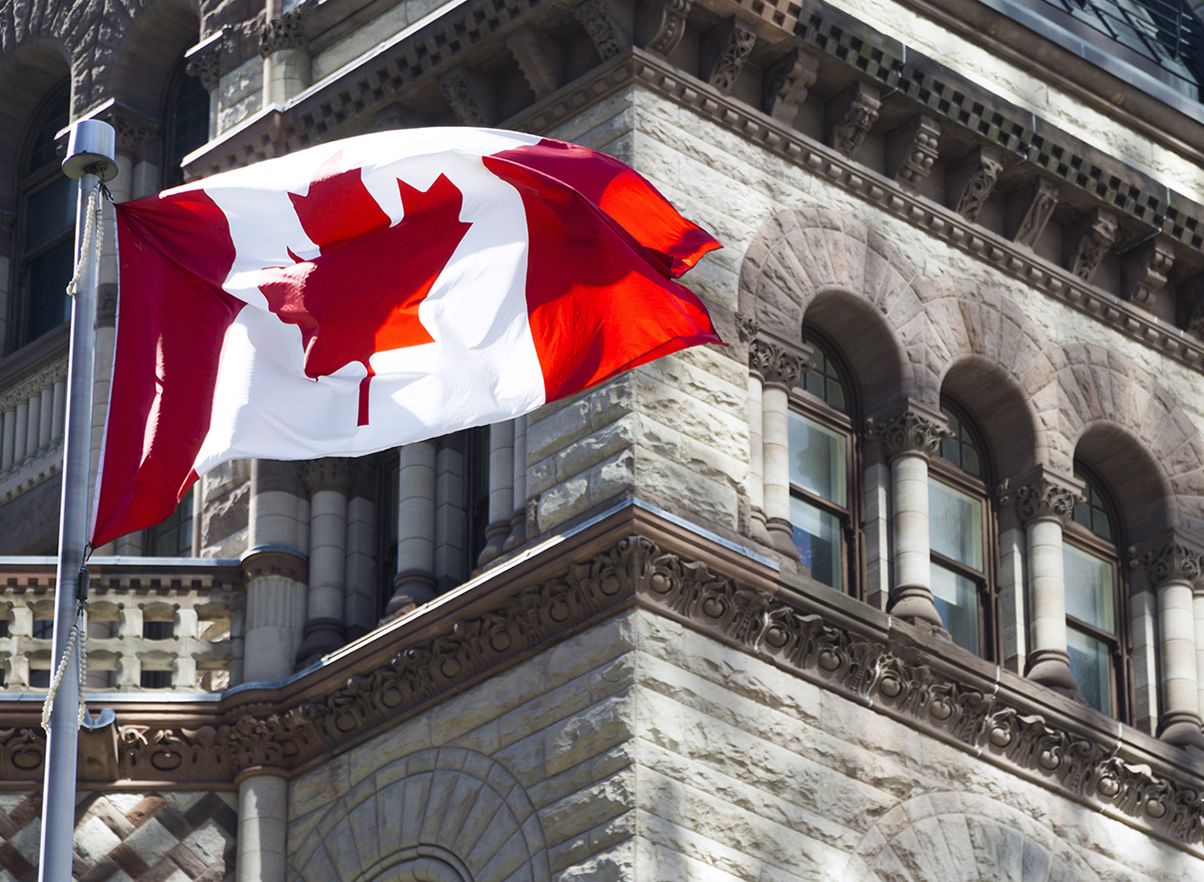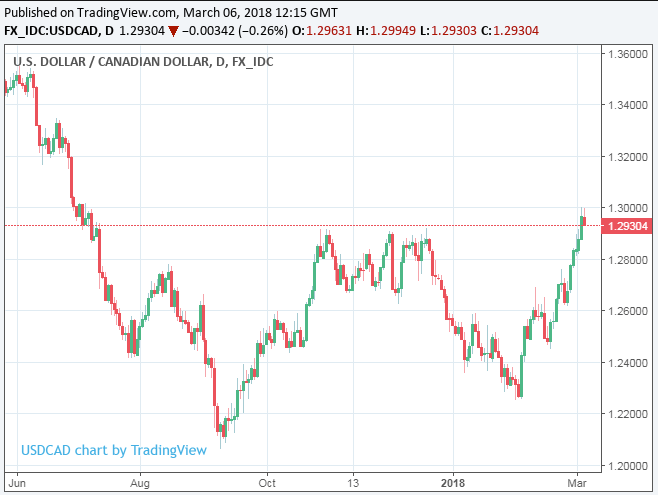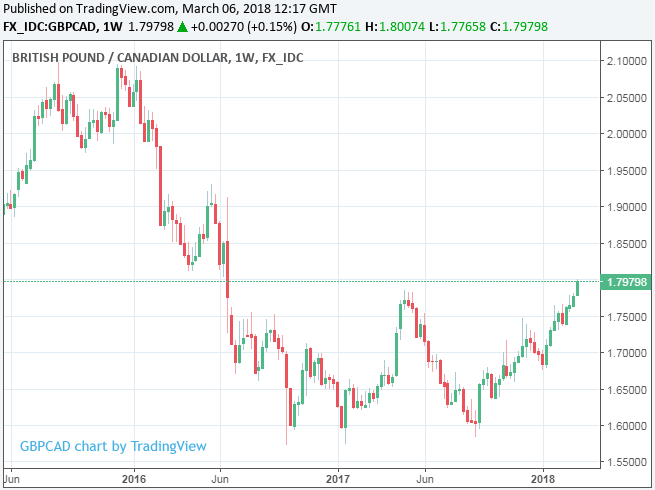Buy the Pound, Sell the Canadian Dollar say Nomura Strategists
- Written by: James Skinner

© COSPV, Adobe Stock
“We still like GBP/AUD upside as a medium-term monetary policy divergence view but we think GBP/CAD over the next few weeks could be the better trade” - Nomura
Pound Sterling is set to continue its uptrend against the Canadian Dollar over coming months, according to strategists, as the Brexit “cliff edge” gets kicked into the long grass by a transition agreement and trade-related threats to the Loonie mount.
The Pound-to-Canadian Dollar exchange rate is quoted at 1.7930 at the time of writing, having gone as high as 1.800 already this month which represents the exchange rates highest level since the June 2016 EU referendum when the Pound plummeted.
Much of the GBP/CAD that analysts at Nomura are forecasting lie with expectations for further Canadian Dollar weakness amidst an environment of rising global trade tensions.
“NAFTA negotiations and the potential for further trade wars will naturally see Mexico and Canada come under pressure as the market’s natural trade proxies. But in addition to trade developments, more fundamentally, we remain bearish on CAD,” says Jordan Rochester with Nomura's London office.
President Donald Trump’s new tariffs on aluminium and steel imports, which have given rise to concerns over a possible trade war, will hit Canada’s exports to its largest market argue Nomura. These tariffs come at a time when the Canadian economy is already facing a possible termination of the North American Free Trade Agreement, which has been subject to a fruitless renegotiation at the behest of the Trump administration.
President Trump once described the NAFTA agreement as “the worst deal in history” and has threatened to withdraw America from the pact if more acceptable terms cannot be negotiated. A number of analysts have said a withdrawal could bring about a double-digit depreciation for the Canadian Dollar.
Rochester and the Nomura FX team say the threat of rising trade tensions may be enough to make the Bank of Canada a bit more cautious about raising interest rates again.
The BoC has already raised Canada’s interest rate three times in the last nine months, with the latest hike taking the base rate up to 1.25% this January. It will announce its latest interest rate decision Wednesday 07 March.
The Loonie has enjoyed considerable support over the last six months as markets adapted their view of Canadian monetary policy over the coming years, but this is now at risk of changing.
Faster economic growth in the US likely means the Federal Reserve will raise interest rates faster in 2018 than it has in prior years, and at a quicker pace than markets had given it credit for, which could be expected to push the Canadian Dollar lower against the US Dollar.
“We still think CAD net-long positioning looks extended, and vulnerable to a pull-back. From a monetary policy perspective, we expect growth in Canada to slow relative to the US, which should suggest a slower pace of tightening by the BoC than the Fed. We expect these drivers to push USD/CAD towards 1.31 or higher,” Rochester writes, in a recent note.

Above: USD/CAD rate shown at daily intervals.
The Bank of Canada is also at risk of being outpaced by the Bank of England, given the BoE has signalled its intention to throw caution to the wind and raise interest rates at a faster pace over coming quarters, in order to bring inflation under control.
BoE rate setters have turned more hawkish at the same time as British and European negotiators are closing on a so called transition deal, which will preserve the status quo for nearly two years after the March 2019 date when the UK is set to exit the EU.
“We expect the necessary agreements to go down to the wire, but eventually a transitional deal to be agreed that will naturally support GBP,” Rochester says.
A transition agreement needs to be wrapped up in time for it to be approved by the European Council at the next leaders summit on March 22.
Once it is in the bag, UK political risks could fade from the market’s view until the next Brexit deadline approaches, in October 2018, which should see the Pound driven increasingly by monetary policy expectations.
“[The] upbeat services PMI figures will keep the Bank of England in a hawkish mood as we approach the 22 March meeting with a BoE communication that could raise the probability of a May hike,” says Rochester, referring to Monday’s IHS Markit Services PMI.
“Even though a hike at the May meeting is 80% priced, the risk is that BoE pricing continues to rise over coming months and years with November our expectation of the timing of the second hike.”
Pricing in interest rate derivatives markets, which enable investors to protect themselves against changes in interest rates while also providing insight into investor expectations for monetary policy, implies an 80% probability that the BoE will raise interest rates again in May 2018.
However, there is a much lesser 30% probability of a November interest rate rise built into the current Sterling Overnight Index Average (SONIA) curve, which suggests a bank rate of 0.83% in November and 0.88% in December.
It is a change in these implied odds that has the power to elicit big bets from Pound Sterling traders and wild swings in currency markets.
Rochester and the Nomura team predict markets will eventually come around to the view that the BoE will act in both May and November.

Above: Pound-to-Canadian-Dollar rate shown at weekly intervals.
“As a short-term tactical trade EUR/GBP downside may not be the best expression of the GBP view. Instead, it’s in the commonwealth where our view best presents itself,” Rochester writes.
“We still like GBP/AUD upside as a medium-term monetary policy divergence view but we think GBP/CAD over the next few weeks could be the better trade.”
Uncertainty over the future of NAFTA and Canadian trade more broadly, combined with an increasingly restless Bank of England, creates a fertile environment in which Sterling could rise further against the Canadian Dollar.
This seems particularly apparent when considering that implied probabilities of further BoC rates hikes this year have been headed in the wrong direction of late.
Interest rate derivatives market pricing implied a Canadian cash rate of 1.783% on January 17, the day when the BoC last raised rates, although this implied rate had fallen to just 1.639% by 08:00 on March 06.
The fall in implied BoC cash rate suggests waning market confidence in the BoC's ability to push rates higher over 2018. The BoC will announce its latest interest rate decision Wednesday at 15:00 London time.
“We are entering a tactical long GBP/CAD position at 1.7833, with a stop at 1.7565 and initial target of 1.83 where we will reassess as we expect the trend to continue,” Rochester says, in a note written Monday 05, March.
The Pound-to-Canadian-Dollar rate was quoted 0.01% higher at 1.7977 during morning trading Tuesday while the USD/CAD rate was 0.25% lower at 1.2946.
Advertisement
Get up to 5% more foreign exchange by using a specialist provider to get closer to the real market rate and avoid the gaping spreads charged by your bank when providing currency. Learn more here.




